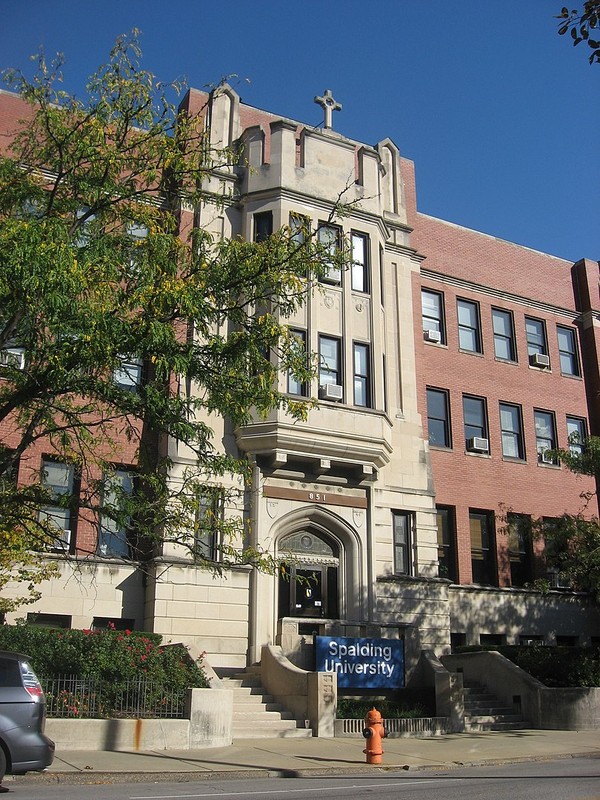Tompkins-Buchanan House (Spalding University)
Introduction
Text-to-speech Audio
Images
Tompkins-Buchanan Mansion in Old Louisville. The building now serves Spading University.

Backstory and Context
Text-to-speech Audio
The Tompkins-Buchanan House, hidden between two wings of the Spalding College administration building, is one of the few surviving works of Louisville's acclaimed architect, Henry Whitestone (1819-93). The mansion's construction and its remodeling reflected the patronage of two prominent Louisville citizens, Joseph T. Tompkins, a wholesale dry-goods merchant, and George Buchanan, a distiller. Their careers speak to the post-Civil War affluence enjoyed by many in Louisville, many of whom moved south of Broadway to an area now known as Old Louisville. After later belonging to members of the prominent Rankin and Shuttleworth families, the house became part of Spalding (then Nazareth) College.
Joseph T. Tompkins, born in Lynchburg, Virginia, in 1820, moved to Louisville at the age of seventeen and took a job as a dry-goods store clerk. Later, he entered the firm of James Low & Company and then established a private wholesale business with his brother, Samuel Tompkins of New York. Outside of a minor setback when the brothers speculated on gold mining during the mid-nineteenth, the brothers became financially successful.
During the 1870s, the southern portion of Fourth Street evolved into a residential neighborhood, contributing to the push southward away from downtown Louisville — a trend noted in many U.S cities during the evolving Gilded Age. The area south of Broadway catered to those with at least modest, if not substantial, wealth. Hence, the area today enjoys numerous historic buildings with elegant architectural detailing. After Joseph Tompkins married Sarah Sawtell, a renowned reverend's daughter, he hired Henry Whitestone, Louisville's most prominent architect during the mid-nineteenth century, to design the grand home in Louisville's southern neighborhood now known as Old Louisville.
Whitestone served as Louisville's most acclaimed architect during the middle part of the nineteenth century. Like the vast majority of his designs, the Tompkins home evoked the palazzi of Renaissance Italian merchant princes in proportions, details, and associations (later renovations removed some of those features.) George C. Buchanan, a distiller, purchased the property in 1880, three years after Tompkins died. He had the interior thoroughly redecorated, and he altered parts of the exterior. Buchanan had the home filled with the most fashionable furniture, detailing, and decor of his day, exhibiting his wealth and status. However, a Courier-Journal article in 1884 shows that his wealth was short-lived; the title of the article was: "The Beautiful Home of the Bankrupt Whiskey King Despoiled by the Auctioneer."
In 1886, Rhodes B. Rankin and James Shuttleworth obtained the property; Rankin bought out Shuttleworth's portion in 1905. In 1918, the Sisters of Charity of Nazareth bought the property and proceeded to open Nazareth College two years later, now known as Spalding College. The college has added structures, such as the mansion's front wing, but the core of the well-maintained Tompkins-Buchanan House has survived. The combination of the original design plus the alterations made, along with its place in Old Louisville, speak to the many histories attached to the building, including the development of Old Louisville as a place for successful middle-class businesspersons, Tompkins and dry goods stores, Kentucky distilling, and the lauded architect, Henry Whitestone.
Sources
Jackson, Kenneth T. Crabgrass Frontier: The Suburbanization of the United States. New York: Oxford University Press, 1985.
Jones, Elizabeth F. "Nomination Form: Tompkins-Buchanan House." National Register of Historic Places. nps.gov. 1977. https://npgallery.nps.gov/GetAsset/23ebcf7b-bdff-485f-8b50-851876877a1b/.
Kleber, John E. The Kentucky Encyclopedia. Lexington: University Press of Kentucky, 1992.
By Nyttend - Own work, Public Domain, https://commons.wikimedia.org/w/index.php?curid=22564200
